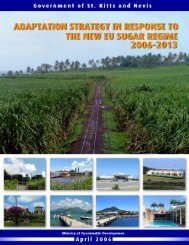Business Removing
Doing Business in 2005 -- Removing Obstacles to Growth
Doing Business in 2005 -- Removing Obstacles to Growth
- No tags were found...
You also want an ePaper? Increase the reach of your titles
YUMPU automatically turns print PDFs into web optimized ePapers that Google loves.
48 DOING BUSINESS IN 2005<br />
Why reform?<br />
Broader sharing of credit information, stronger legal<br />
rights in and out of bankruptcy and more efficient<br />
enforcement mean more credit (figure 6.7). Analysis of<br />
credit markets over the last 25 years shows that introducing<br />
information sharing and strengthening rights in<br />
bankruptcy expand credit, even controlling for other determinants<br />
of lending. 17 In poor countries, information<br />
sharing works better than legal rights.<br />
The most credit constrained—small firms, women<br />
and poor people—gain the most. 18 All firms are more<br />
likely to have loans from financial institutions in countries<br />
with stronger legal rights. But the relationship is<br />
larger and more significant for small firms. 19 One study<br />
shows that small firms are 40% more likely to have a<br />
bank loan in countries with credit registries. 20 Why? Because<br />
registries help sort good borrowers from bad.<br />
There are more benefits. Countries with stronger<br />
legal rights have fewer nonperforming loans, even controlling<br />
for income per capita. <strong>Business</strong>es report fewer<br />
credit constraints. They also get cheaper loans—lending<br />
rates and spreads between lending and deposit rates are<br />
significantly lower. And ratings of financial system stability<br />
are higher. 21<br />
The result: higher productivity and more growth.<br />
Adding one of the features in the information-sharing<br />
index is associated with 6 percentage points more credit<br />
to the private sector (as a share of GDP). This implies<br />
that moving from a score of 0 to 5 on the credit information<br />
index is associated with 0.9 percentage points<br />
more GDP growth and 0.7 percentage points more productivity<br />
growth. Reforming legal rights in Egypt or<br />
Turkey to the level of Botswana or Jordan suggests 1.1<br />
percentage points in more economic growth and 0.9 percentage<br />
points higher productivity growth (figure 6.7). 22<br />
FIGURE 6.7<br />
Better legal protections and more credit information lead to higher growth<br />
Stronger legal rights, more credit<br />
(Credit as a percentage of GDP)<br />
More<br />
credit<br />
More information sharing, more credit<br />
(Credit as a percentage of GDP)<br />
More<br />
credit<br />
More credit, higher growth<br />
(percentage points)<br />
1.1 Egypt,<br />
Arab Rep.<br />
0.9 Brazil<br />
0.9 Turkey<br />
Less<br />
credit<br />
Less<br />
credit<br />
0.7 Yemen, Rep.<br />
0.5 Cambodia<br />
0.7 China<br />
0.6 Côte d’Ivoire<br />
0.4 Pakistan<br />
Least rights<br />
Most rights<br />
Countries ranked by legal rights index<br />
quintiles<br />
Least sharing<br />
Most sharing<br />
Countries ranked by information sharing index<br />
quintiles<br />
Note: The relationships are significant at the 1% level and remain so at the 5% level when controlling for income per capita.<br />
Sources: Doing <strong>Business</strong> database and King and Levine (1993).<br />
Added<br />
GDP<br />
Added<br />
productivity growth<br />
Note: Based on implied growth from increasing the legal rights<br />
score to the 75th percentile.<br />
Notes<br />
1. Batra and others (2003).<br />
2. Even for larger firms, gender differences remain. See Center for<br />
Women’s <strong>Business</strong> Research (2004) and Weeks and Seiler (2001).<br />
3. Grameen Bank (2004).<br />
4. See also Littlefield and others (2003), World Bank (2001).<br />
5. The standardized case assumes a value of debt and security of 10 times<br />
income per capita.<br />
6. Judgment creditors are given the right to an asset by court verdict.<br />
7. World Bank (2004b).<br />
8. This 4-point measure of creditor rights was developed by La Porta,<br />
Lopez-de-Silanes, Shleifer and Vishny (1998) and covered 49 countries.<br />
9. The lack of reform in 2003 is not an aberration. Only 30 countries<br />
changed their creditor rights in bankruptcy score in the last 25 years.<br />
10. Dahan and Simpson (2004).<br />
11. See also Barron and Staten (2003) for micro evidence of this effect.<br />
12. In another 7—Chile, Costa Rica, Hungary, Pakistan, Paraguay, Spain<br />
and Uruguay—the private bureau distributes only negative data but<br />
positive data is available from the public registry.<br />
13. See also Barron and Staten (2003) for micro evidence of this effect.<br />
14. Royal Bank of Canada (2004).<br />
15. Either through title finance or a traditional security instrument.<br />
16. These countries require lenders to take title to the collateral.<br />
17. Djankov, McLiesh and Shleifer (2004).<br />
18. See Beck, Demirgüç-Kunt and Maksimovic (forthcoming) and Gropp<br />
and others (1997) for evidence on small firms.<br />
19. Based on analysis of the Doing <strong>Business</strong> legal rights of borrowers and<br />
lenders indicator with firm level data on access to bank finance, as reported<br />
in Batra and others (2003).<br />
20. Love and Mylenko (2003).<br />
21. Based on analysis of the Doing <strong>Business</strong> legal rights of borrowers and<br />
lenders indicator with: The IMF Global Stability Report measure of<br />
nonperforming loans; International Financial Statistics lending and deposit<br />
rates; Global Competitiveness Report 2003–04 ratings of the ease<br />
of getting loans and financial system soundness, and Moody’s strength<br />
of financial system rating. Relationships are significant at the 5% level.<br />
All analysis controls for income per capita.<br />
22. Calculations based on King and Levine (1993).

















